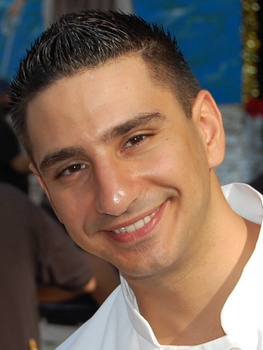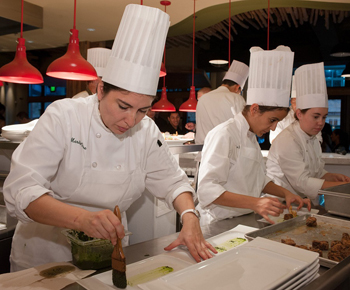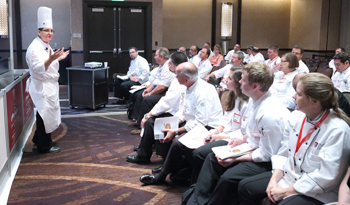Mayo’s Clinic: Helping Students Take Charge—the Three-Legged Conference
 The value of a three-legged conversation is that you can make some statements or ask questions that prompt students to think about the topic they are raising, and you do not have to completely answer the question in one meeting.
The value of a three-legged conversation is that you can make some statements or ask questions that prompt students to think about the topic they are raising, and you do not have to completely answer the question in one meeting.
By Dr. Fred Mayo, CHE, CHT
Last month, we discussed ways to begin a semester by making our students feel special; this month and for the rest of the fall, we will talk about ways to help them learn to take charge of their education and their lives. This month will focus on the strategy of the three legged conference.
Students Taking Charge of Themselves
One of the important goals of any teaching situation is promoting creative and critical thinking. However, we often apply it only to the subject matters that we formally teach and not very often to helping students become better industry professionals and better persons for several reasons: There is not enough time in class, these subjects are not part of the curriculum, and most of us never learned how to teach about professional and personal development.
When you stop to think about it, helping our students to build their decision-making skills is a great goal, and one that many of us in culinary and hospitality education have adopted, even if only on the edges of our teaching. After all, helping our students to become better professionals is an important part of our commitment to them and a unique aspect of culinary and hospitality education; other fields do not care so much about that aspect of their students’ lives. If you want to commit to this goal, there are several strategies; the easiest is using the three-legged conference to promote their thinking about themselves.

 Continuing the theme of helping students work together successfully to better prepare them for real-life employment, Chef Weiner suggests strategic ways to group team members who don’t necessarily see eye to eye.
Continuing the theme of helping students work together successfully to better prepare them for real-life employment, Chef Weiner suggests strategic ways to group team members who don’t necessarily see eye to eye. Through the company’s Green Thread® program, concessioner ARAMARK works to reduce its environmental footprint by developing and implementing long-term environmental stewardship programs and policies for its state- and national-park accounts, diverting nearly 3 million pounds of waste from landfills.
Through the company’s Green Thread® program, concessioner ARAMARK works to reduce its environmental footprint by developing and implementing long-term environmental stewardship programs and policies for its state- and national-park accounts, diverting nearly 3 million pounds of waste from landfills. Marco Chirico, at only 25, is already moving a legacy into the next generation via his father’s restaurants—one operating for three decades and one a few years young—in Brooklyn.
Marco Chirico, at only 25, is already moving a legacy into the next generation via his father’s restaurants—one operating for three decades and one a few years young—in Brooklyn. “Gold Medal Classroom” readers who answer a survey (see link below) will receive a special code for a $200 discount on Worlds of Flavor® 2013 registration. Also, all names will be placed into a drawing for one free Worlds of Flavor registration, and three respondents will receive a choice of one of three CIA books.
“Gold Medal Classroom” readers who answer a survey (see link below) will receive a special code for a $200 discount on Worlds of Flavor® 2013 registration. Also, all names will be placed into a drawing for one free Worlds of Flavor registration, and three respondents will receive a choice of one of three CIA books. As students go to college this fall, The Culinary Institute of America (CIA) is offering them exciting new education options. These new concentrations—in beverage management, farm-to-table cooking and Latin cuisines—give students the chance to focus their studies on a particular area of interest in the food world.
As students go to college this fall, The Culinary Institute of America (CIA) is offering them exciting new education options. These new concentrations—in beverage management, farm-to-table cooking and Latin cuisines—give students the chance to focus their studies on a particular area of interest in the food world. As the American Culinary Federation’s 2013 National Chef Educator of the Year learned from her fourth-grade teacher, to achieve success in the classroom, a good instructor must be able to recognize the learning styles of his or her students and adjust his or her teaching style accordingly. Because every student deserves a Miss Farber.
As the American Culinary Federation’s 2013 National Chef Educator of the Year learned from her fourth-grade teacher, to achieve success in the classroom, a good instructor must be able to recognize the learning styles of his or her students and adjust his or her teaching style accordingly. Because every student deserves a Miss Farber. Culinary instructors from across the nation recently participated in Emmi Roth USA culinary-externship program and American Cheese Society conference events.
Culinary instructors from across the nation recently participated in Emmi Roth USA culinary-externship program and American Cheese Society conference events.